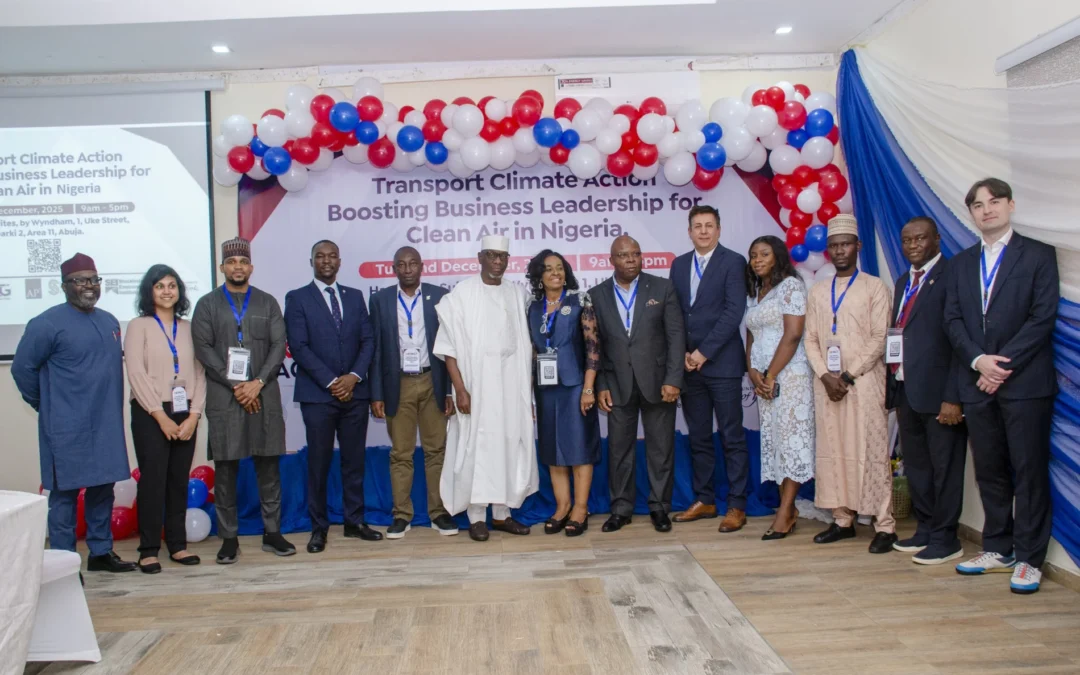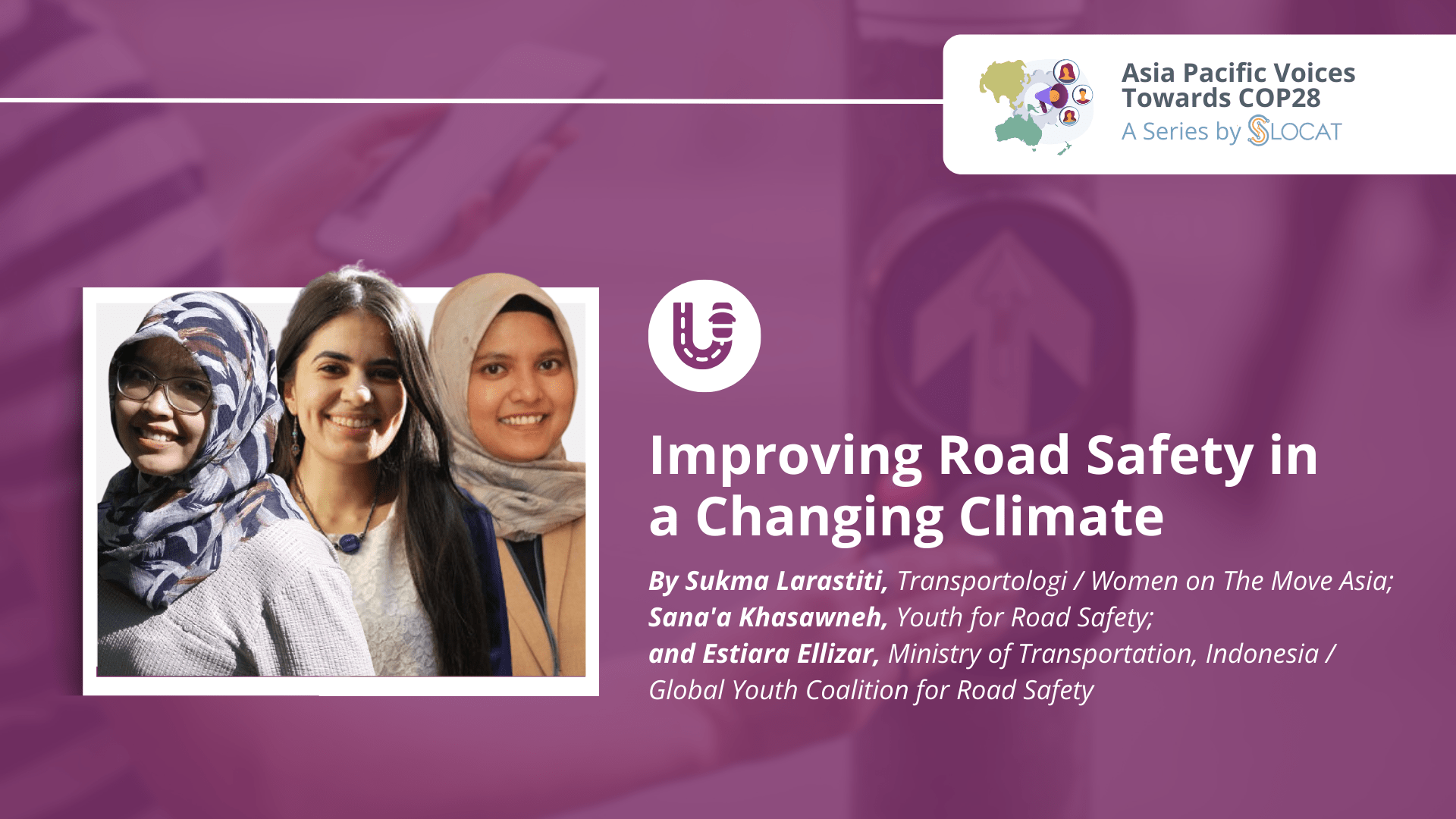By Sukma Larastiti, Founder and Director, Transportologi / Women on The Move Asia; Sana’a Khasawneh, Junior Project Manager, Youth for Road Safety; and Estiara Ellizar, Transport Planner, Ministry of Transportation, Indonesia / Global Youth Coalition for Road Safety
Road safety is a global crisis – more than 1.35 million people die on the roads annually around the world, according to the World Health Organisation (WHO).¹ It is no surprise that road traffic crashes are considered as a ‘silent killer’ for young people (5-29 years old), especially in low-and middle-income countries. Very often, we think road traffic crashes are caused by reckless vehicle drivers, but a more silent and growing ‘killer’ is the changing climate.
Taking Jordan as an example: The country has experienced an increasing number of extreme weather events which have had severe implications for road safety in recent years. In the country, heavy rainfall often occurs after extended dry periods. These sudden downpours can create hazardous road conditions, including reduced visibility, slippery surfaces, and an elevated risk of hydroplaning. Such conditions can lead to road accidents.² Jordan has also witnessed a notable increase in the frequency and intensity of heat waves over the past decade.³ Extreme heat can soften and damage road surfaces, making them more susceptible to wear and tear. This deterioration can result in uneven road surfaces and reduced traction, increasing the risk of accidents, especially during the summer months. During periods of intense heat or heavy rainfall, there was a notable increase in the number of road crashes, particularly in regions where road infrastructure was less resilient to these weather-related challenges.⁴
Among these events was a tragic incident on October 25, 2018, where a mere 15 minutes of rain unleashed killer flash floods in the Zarqa-Maeen Valley near the Dead Sea.⁵ This devastating event claimed the lives of 21 individuals, including 16 school children, casting a grim shadow over the region. The incident served as a stark reminder of the immediate road safety risks posed by extreme weather events in Jordan. Vulnerabilities in the country’s road infrastructure were laid bare, with roads washed out and underpasses submerged, making transport perilous. These flash floods were not isolated occurrences. Hailstorms, severe dust storms with wind speed up to 100 km/h also significantly reduced road visibility in the south and east of the country, causing potential dangers to road users (pedestrians, cyclists, motorists and vehicle drivers).⁶
In response, Jordan faces the urgent task of developing adaptive strategies and resilient infrastructure to confront the growing challenges posed by climate change and safeguard the safety of its citizens on the roads. Some measures taken include:
- Road Maintenance: Increased investment in road maintenance and repair programs, focusing on the use of heat-resistant road materials.
- Improved Drainage: Upgrading drainage systems to manage heavy rainfall and prevent flooding on roadways.
- Public Awareness: Launching public awareness campaigns to educate road users about the risks associated with extreme weather conditions and encourage safe driving behaviours.
Jordan is hardly the only country facing the problem. Data shows that most of the infrastructures in Asian countries are prone to climate change with increasing risks to road safety.⁷
Time to take Action
Our roads, once sturdy conduits of journeys, are now subject to the whims of a changing climate. These shifts remind us of the delicate balance we tread upon. Yet, in this dance of uncertainty, lies an opportunity to fortify our routes against the challenges of a shifting world.
The impact of climate change on road crashes, particularly through its influence on infrastructure, is a pressing concern. Rising temperatures, extreme weather events, and changing precipitation patterns can lead to the degradation of road surfaces, reduced visibility and increased hazards for drivers. To address this critical issue, there is a growing need for comprehensive studies that delve into the intricate relationship between climate change, road safety, and infrastructure resilience. These studies should provide evidence-based interventions and strategies to mitigate the escalating risks of road crashes due to climate-related factors. By understanding the nuances of this connection and implementing effective measures, we can work towards safer and more resilient transport systems in the face of the changing climate.
Current road safety measures focus mainly on death and injuries by traffic crashes. We should start to record road safety incidents related to climate change and disasters. This data will help in identifying trends, vulnerable areas, and the types of accidents that are most prevalent during climate-related events.
A specific road safety index for climate change would also contribute to measure the preparedness and resilience of road infrastructure during extreme weather events, such as floods, hurricanes, and wildfires. For example, the infrastructure vulnerability index from ND-GAIN focuses on the projected changes of sea level rise impacts, population living under 5m above sea level, electricity access and disaster preparedness. Climate change disasters on the road are road safety problems.
We must prioritise climate adaptation strategies for public transport and integrate climate resilience into urban planning. These actions consequently can increase our road safety in the long term for diverse road users. The strategies should be equipped with an emergency evacuation plan and warning system for the people on the road who are impacted by the disaster. This system should include real-time weather monitoring, flood and landslide alerts, and traffic management strategies during extreme events.
We also need climate-resilient infrastructure to reduce road deaths and injuries from climate disasters. This includes building and maintaining roads, bridges, and drainage systems that can withstand the impact of climate disasters. Regular inspections and upgrades should be conducted to ensure resilience.
Additionally, fostering education and awareness around the relationship between road safety and climate change equips us with knowledge to mitigate road safety risks on the road.
By embracing adaptable road design, resilient infrastructure, and proactive measures, we can harmonise our travels with the changing climate. It is a journey not only towards safer roads but also a nod to the wisdom of coexisting with our planet’s evolving tapestry. By that, we not only ensure a more equitable future but also pave the way for a sustainable and resilient society.
[1] World Health Organisation (2018), “Global status report on road safety 2018”, https://www.who.int/publications/i/item/9789241565684, accessed 11 October 2023.
[2] Jordan Meteorological Department. (2019), “Climate Change Scenarios and Hydrological Impacts for Jordan”.
[3] Namrouqa, H. (2018), “Floods ‘only beginning’ of severe climate change impacts on Jordan”, The Jordan Times. https://jordantimes.com/news/local/floods-only-beginning-severe-climate-change-impacts-jordan, accessed 11 October 2023.
[4] Ibid.
[5] The Watchers (2018), “First heavy rainfall of the season, deadly flash floods hit Jordan’s Zarqa-Maeen Valley”, https://watchers.news/2018/10/28/flood-zarqa-maeen-jordan-october-25-2018/, accessed 11 October 2023.
[6] Ibid.
[7] Asian Transport Outook 2023, https://asiantransportoutlook.com/snd/, Accessed 19 October 2023
[8] Ibid.

Sukma Larastiti
Sukma Larastiti is a transport consultant involved in projects like bike sharing and lane planning in Bandung. She is also the Founder and Director of Transportologi, an organization advocating for urban transport policy and collaborating on projects to improve road safety and public transportation. Additionally, she has worked as a Short-Term Expert in Urban Public Transport with Deutsche Gesellschaft für Internationale Zusammenarbeit (GIZ) GmbH, contributing to the preparation of low emission and electrification public transport in the Green Infrastructure Initiative project for Solo Greater Area in Central Java, Indonesia. Sukma actively participates in initiatives promoting sustainable and accessible transportation.





















